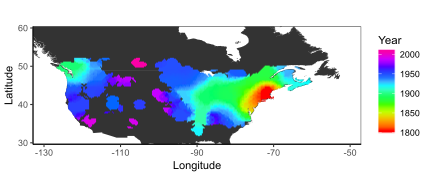Rapid shifts in phenology during biological invasions can increase survival and reproduction of invasive species, contributing to their spread and impact. However, it is not clear how quickly invasive populations can tune their phenology in response to local environmental cues. Global herbarium specimens represent spatial and temporal snapshots of phenology that could be analyzed for environmental tuning in the form of correlations between phenological development and local climatic factors. We combined inflorescence measurements of herbarium specimens with historical weather data to investigate modern and historic clines in flowering phenology throughout the North American distribution of the invasive plant Lythrum salicaria (purple loosestrife).

Krieged map of L. salicaria spread using occurrence data from BISON.
Lythrum salicaria was introduced to eastern North America from Europe over 200 years ago, but spread slowly until approximately 60 years ago when it rapidly expanded northward and westward. Field surveys and experimental manipulations have demonstrated rapid evolution of locally adaptive clines in flowering time along a latitudinal gradient in eastern North America. We characterized inflorescence morphology (i.e. buds, flowers, fruits) of 3,427 herbarium specimens and interpolated growing season and growing-degree days by inverse distance weighing of nearby NOAA weather station data.
Phenological state, after controlling for variation in collection date and local growing conditions, showed similar correlation with latitude similar to latitudinal flowering clines from four separate common-garden populations. We modeled phenological development using a non-linear least squares model incorporation growing season length, growing season days, and time since invasion. Growing season length and time since invasion significantly affected estimated phenological clines.